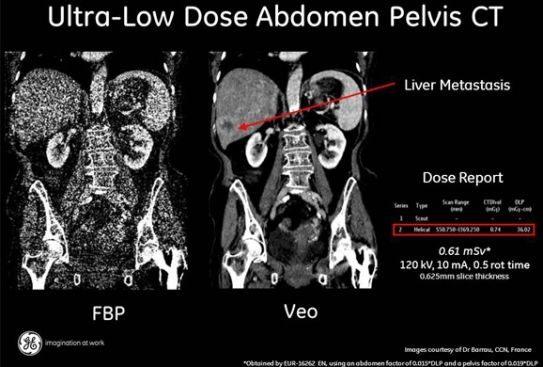GE's CT Image Reconstruction Technology Receives FDA Clearance
GE Healthcare this week announced the FDA 510(k) clearance of its computed tomography (CT) technology that uses a new reconstruction method to improve image clarity at a lower dose. GE’s Veo represents the CT industry’s first Model-based Iterative Reconstruction Technique (MBIR), according to company officials.
GE Healthcare this week announced the FDA 510(k) clearance of its computed tomography (CT) technology that uses a new reconstruction method to improve image clarity at a lower dose.
GE’s Veo represents the CT industry’s first Model-based Iterative Reconstruction Technique (MBIR), according to company officials. It is housed on GE Discovery CT750 HD systems, and is already available in Europe, Canada, and parts of Asia.
In clinical trials with Veo users in Europe showed “profound image clarity at yet unseen low dose levels,” the company said. Users reported successful chest CTs done with an equivalent amount of radiation as a chest X-ray, or less than one-tenth of one mSv.
The new method, MBIR, complements GE’s Adaptive Statistical Iterative Reconstruction (ASiR) technique.
Conventional reconstructive technology, Filtered-Back Projection (FBP), takes a single pass through the raw data, but doesn’t account for the noise in the image. As a model-based technology, Veo makes a first estimate of the image, then goes back and iterates to compare how accurate it is to the actual CT data. It continues to iterate on that process to refine it to an optimal image, Scott Schubert, GE’s general manager for Premium CT Product Marketing, said in an interview.
Schubert noted that CT has made evolutionary advances in terms of the number of slices and speed, but that image reconstruction hasn’t changed much over time. “This technology is a real breakthrough in terms of moving the CT clarity and the dose performance to a whole new level of capability,” he said.
GE is also coordinating a multi-center study to further evaluate improvements, including lower dose levels, and results are expected to be available later next year.
“Veo’s revolutionary capabilities change the rules of CT imaging, and represent our promise to help eliminate the traditional trade-off between image clarity and low dose levels as we help healthcare professionals offer the best patient care possible,” Steve Gray, vice president and general manager of CT and Advantage Workstation for GE Healthcare, said in a statement.

Courtesy GE Healthcare
For more on MBIR, check out this video with William Shuman, MD, FACR, Professor and Vice Chairman for the Univ. of Washington Department of Radiology, discussing MBIR at the 2011 ISCT meeting in San Francisco.
GE HealthCare Debuts AI-Powered Cardiac CT Device at ACC Conference
April 1st 2025Featuring enhanced low-dose image quality with motion-free images, the Revolution Vibe CT system reportedly facilitates improved diagnostic clarity for patients with conditions ranging from in-stent restenosis to atrial fibrillation.
The Reading Room Podcast: Current Perspectives on the Updated Appropriate Use Criteria for Brain PET
March 18th 2025In a new podcast, Satoshi Minoshima, M.D., Ph.D., and James Williams, Ph.D., share their insights on the recently updated appropriate use criteria for amyloid PET and tau PET in patients with mild cognitive impairment.